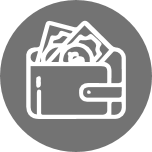What is a spending plan?
If the words “spending plan” sound scary, or like too much work, don’t panic. A spending plan helps you get control over your money and spending. It’s actually simple: your spending plan can help you set aside enough to pay your bills and save for emergencies and for your long-term goals. A Spending Plan:
- Becomes your personal strategy
- Can be a simple document or form
- Helps you live within your means
- Helps you avoid too much debt
- Helps you pay your bills
- Highlights your savings and money to spend
Having a written spending plan can help you make better money decisions. Try putting it down on paper or recording it online so you can review and make regular adjustments.
Remember: How you spend, and how much you spend, is really up to you.
What you need to know about a spending plan

my spending plan
You have a spending plan… now what?
After writing your spending plan, you may find that there’s not enough money to go around. Be realistic and flexible. The goal is to spend less than you make so you still have some money left over for other things you want to do.
Since your fixed expenses may be difficult to change, look for ways to decrease your flexible and discretionary expenses and/or increase your income.
Most people can’t afford everything they want to buy, so they have to make trade-offs. Making trade-offs may mean giving up things you can do without, or buying something less expensive that still meets your needs, in order to afford the things that are most valuable to you. The idea of making trade-offs may also relate to how you spend your time. For example, to make more money at your job, you may have to work more hours.
Savings is a discretionary expense because it’s up to you to decide how much of your money you’re going to set aside for your future. Each month as you pay everyone else for things you need and want, don’t forget to “pay yourself” by saving.
To make your monthly income last, pay for things in this order.
- Pay your monthly bills. There are many potential penalties if you pay late, such as late fees, losing possession of things you’ve bought on credit, even being evicted from an apartment!
- Set aside the money you’ll need for your weekly and day-to-day expenses, like groceries and bus fare.
- Put money into savings. Try to build two months of take-home pay for an unexpected financial emergency.
- Set aside money for larger expenses you know are coming, such as car repairs or appliances.
- Set aside money for your major future goals whether it’s a home, college for your children, a new car, or travel.
Remember: Paying bills late can seriously damage your future ability to borrow. If you begin to earn more, increase the amount you save as much as you can.
spending habits checklist
spending step-by-step
To make your monthly income last, pay for things in this order.
- Put money into savings – Try to build savings to cover three to six months of expenses so that you have money set aside for an unexpected financial emergency.
- Pay your monthly bills – There are many potential penalties if you pay late, such as late fees, losing possession of things you’ve bought on credit, even being evicted from an apartment.
- Set aside money you’ll need for your weekly and day-to-day expenses. Like parking fees or laundry.
- Set aside money for larger expenses – You know are coming, such as car repairs or appliances.
- Set aside money for your major future goals – Such as a house, travel, or retirement savings.
- Save more as you earn more. If you begin to earn more, increase the amount you save as much as you can.

decrease your expenses
Do you find yourself running short on cash month-to-month? The solution is easy to identify but may be challenging to execute; increase your income and/or decrease your expenses. Here are helpful tips for decreasing the expense side of your money picture:


